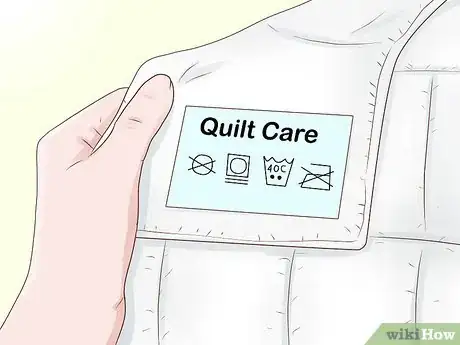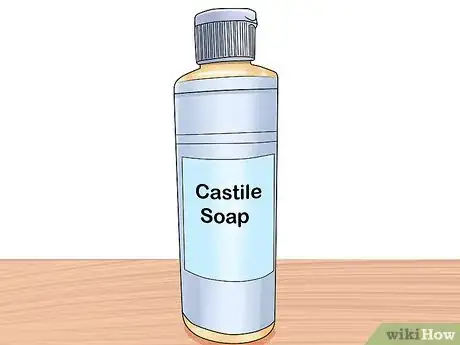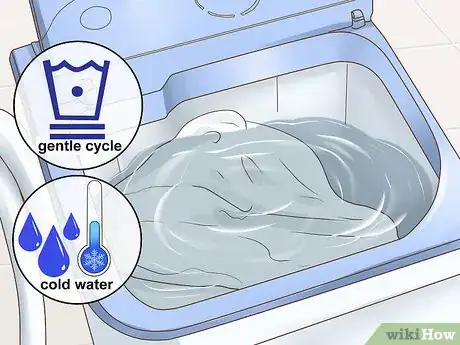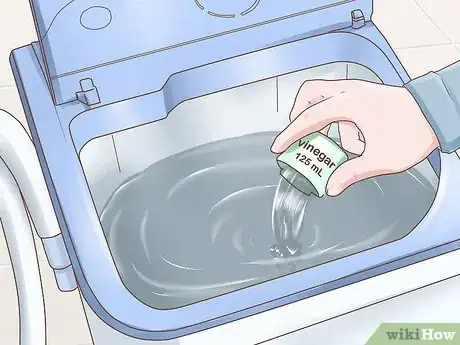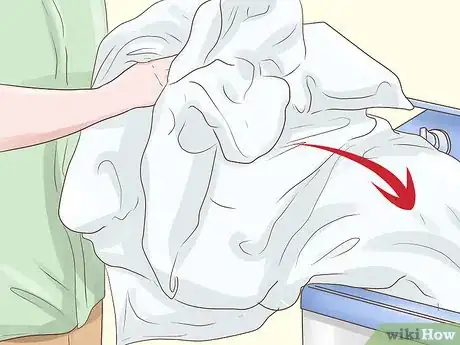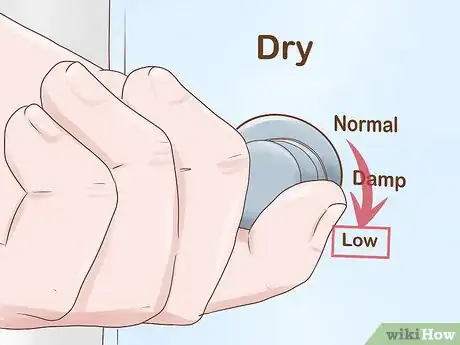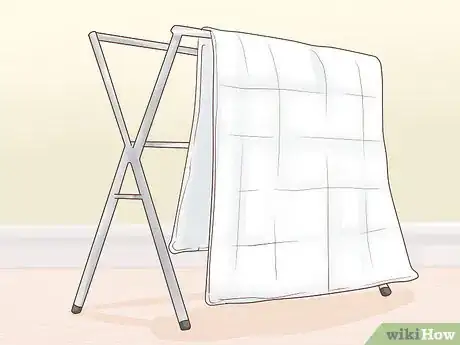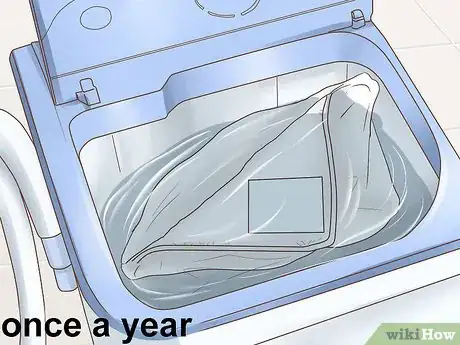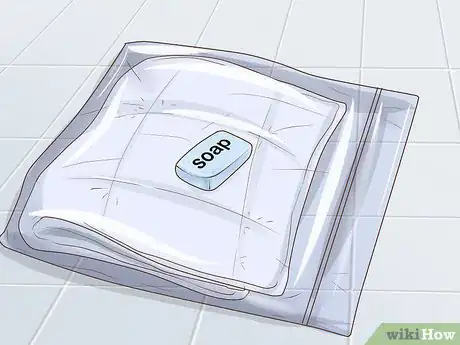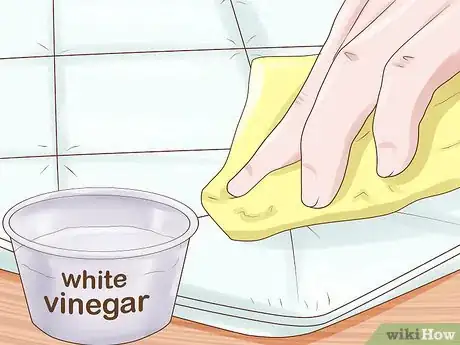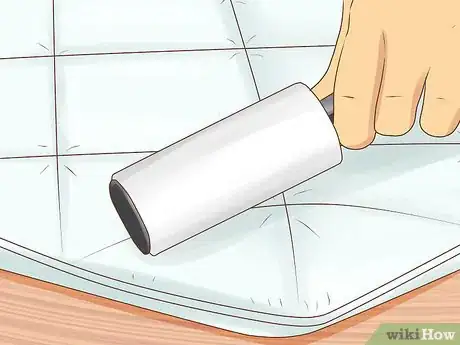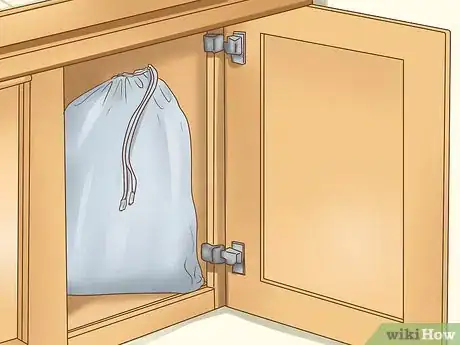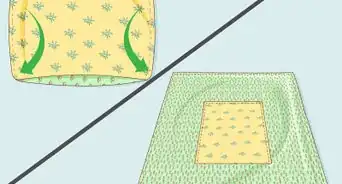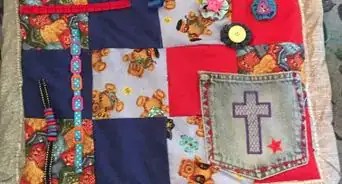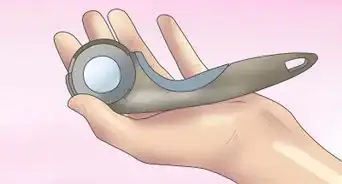This article was co-authored by wikiHow Staff. Our trained team of editors and researchers validate articles for accuracy and comprehensiveness. wikiHow's Content Management Team carefully monitors the work from our editorial staff to ensure that each article is backed by trusted research and meets our high quality standards.
This article has been viewed 34,248 times.
Learn more...
Wash your quilt once a year – more often, if it’s soiled – with cold water, by hand or in a washing machine. Dry your quilt in the dryer on a gentle setting, outdoors, or indoors with a fan. Air out your quilt regularly. Vacuum and spot treat the quilt, as needed. If your quilt is delicate, opt for a lint roller instead of a vacuum.
Steps
Washing a Quilt
-
1Inspect the quilt. Look for a care tag with guidelines for washing and drying. If there is one, follow the instructions provided. Check the quilt for embellishments, appliques, and loose seams or lace. See if there are any highly saturated or contrasting colors, hand dying, or batiks.
- Quilts with embellishments shouldn’t be washed in a washing machine. Loose seams should be repaired before washing the quilt.[1]
- Quilts with vivid colors may bleed. Test the fabric with white cotton fabric dipped in hot water. Rub the quilt’s highly saturated area and see if any color comes off. If so, use a color catcher product in the washing machine.
-
2Select an appropriate detergent. Choose a liquid-based detergent that is colorless and unscented, without any fabric softener, brighteners, or bleach.[2] You can purchase special laundry soap specifically for quilts, if desired. Alternately, use baby shampoo instead of laundry detergent.[3]
- For example, castile soap is safe to use on quilts.
Advertisement -
3Use cold water and a short, gentle cycle. Alternately, if your quilt is delicate or not cotton-based, you can hand wash it in a large tub. Let the detergent completely dissolve, then stir the quilt gently in the water.[4]
- Never use hot water to wash a handmade quilt. Don’t use the normal wash and spin cycles of your washing machine.[5]
- If your quilt is yellowed or has an odor such as smoke, soak it overnight first in cold water.
- You may want to wash the quilt in cold water a second time, without any detergent, to ensure that no detergent residue remains on the fabric.[6]
-
4Add vinegar to the wash, if desired. Pour half a cup (125 mL) of distilled white vinegar into your wash cycle. This will help keep the colors of your quilt bright.[7]
Drying a Quilt
-
1Transfer the wet quilt carefully to its drying location. Support the weight of the wet quilt as you transport it. Hold it like a baby, and don’t pull on any one section of the fabric.
- If the weight isn’t properly supported, threads in the quilt may pop.[8]
-
2
-
3Air out the quilt outdoors. You can air out your quilt outside to dry it, if it’s dusty, or if it has an odor. Find an area in the shade, since direct sunlight can fade fabric. Hang it on a balcony or clothesline, or spread it out on the ground. If you spread it on the ground, place a bedsheet underneath it and another on top of it. Weigh the corners down.[11]
- You can also air dry a quilt on a balcony by laying down a mattress pad and spreading the quilt out on top of it. If birds are a concern, spread another mattress pad on top. Turn the quilt over when the top is nearly dry.
-
4Air-dry the quilt indoors. If the weather isn’t appropriate for outdoor drying, line dry the quilt by placing it flat on a rack. Alternately, place a few mattress pads on a bed (at least one of them should be waterproof). Set up a fan to blow horizontally towards the quilt for about a day.
Maintaining a Clean Quilt
-
1Wash your quilt only when necessary. Washing your quilt only when it’s soiled will extend its life. Wash your quilt once per year, even if you use it daily. In between washings, air it outside on a drying rack.[12]
- If your quilt is a decorative accent that is hardly used, opt for airing it out a few times a year instead of cleaning it.
- You may need to wash the quilt more often than annually if it’s used by children, pets, or if someone in the home has allergies.
-
2Freshen the scent of your quilt without washing it. Try placing the quilt in a sealed bag with a bar of soap for a day or two. Alternately, you can try using a fabric freshener product; just make sure to spot test a small, inconspicuous area first for color-fastness.[13]
-
3Spot clean your quilt, as needed. You can treat stains by gently dabbing them with white vinegar or a quilt soap, diluted with distilled water.[14] Make sure to blot and not rub the stain. Put a white cloth below the quilt, then flush the area with cold water.
- Don’t use any soap or detergent that contains bleach.
- If the markings are lines from the quilting process, you can brush off white lines or dab them with a damp cloth. Gray lines are usually pencil and you can remove them gently with a gum eraser.[15]
-
4Use a lint roller or vacuum, as needed. Rub a lint roller across the whole front and back of the quilt. This will remove lint, pet hair, thread tails and loose threads.[16] If your quilt isn’t very delicate, you can vacuum it on the lowest setting, using a brush attachment covered with pantyhose.[17]
-
5Store your quilt in a fabric bag in a dark, dry location. If your quilt is not in use, place it in a cotton or muslin bag. Make sure the quilt is clean before storing it. Remove and refold it monthly. Air out your quilt when you take it out of storage, outside or in a drier (on the low, tumble setting).[18]
- For example, try storing your quilt in a cotton pillowcase.
Community Q&A
-
QuestionHow do I rid my quilt of mealy worms?
 T. ChinsenTop AnswererAn application of a mix of salt and baking soda will dessicate the worms, as they have thin skins. Make sure they are completely covered by the mix, and leave it on for 24 hours. Dispose of the mix and wash the quilt according to its fiber content.
T. ChinsenTop AnswererAn application of a mix of salt and baking soda will dessicate the worms, as they have thin skins. Make sure they are completely covered by the mix, and leave it on for 24 hours. Dispose of the mix and wash the quilt according to its fiber content.
Warnings
References
- ↑ https://www.amishcountrylanes.com/Pages/QuiltCare.shtml
- ↑ http://www.quilting101.com/care/quilt-washing
- ↑ https://pioneerthinking.com/handmade-quilt-care
- ↑ https://www.amishcountrylanes.com/Pages/QuiltCare.shtml
- ↑ https://pioneerthinking.com/handmade-quilt-care
- ↑ http://www.quilting101.com/care/quilt-washing
- ↑ https://www.amishcountrylanes.com/Pages/QuiltCare.shtml
- ↑ https://www.amishcountrylanes.com/Pages/QuiltCare.shtml
- ↑ http://www.quilting101.com/care/quilt-washing
- ↑ https://www.amishcountrylanes.com/Pages/QuiltCare.shtml
- ↑ https://www.apqs.com/how-to-clean-your-quilt-for-judging/
- ↑ https://www.amishcountrylanes.com/Pages/QuiltCare.shtml
- ↑ https://www.apqs.com/how-to-clean-your-quilt-for-judging/
- ↑ https://www.nationalquilterscircle.com/article/quilt-care-part-1-how-to-clean-a-quilt/
- ↑ https://www.amishcountrylanes.com/Pages/QuiltCare.shtml
- ↑ https://www.apqs.com/how-to-clean-your-quilt-for-judging/
- ↑ http://www.apartmenttherapy.com/how-to-clean-a-quilt-135943
- ↑ https://www.amishcountrylanes.com/Pages/QuiltCare.shtml
- ↑ http://www.quilting101.com/care/quilt-washing
- ↑ https://pioneerthinking.com/handmade-quilt-care
- ↑ https://pioneerthinking.com/handmade-quilt-care
About This Article
To clean a quilt, start by checking for a care tag. In general, if your quilt is made of cotton or other sturdy fabric, you can use the washing machine to clean it. Pour unscented and colorless liquid detergent or baby shampoo into the machine and place the quilt into the drum. Select cool water mode on a short, gentle cycle for best results. When the quilt is cleaned, place it in the dryer to tumble dry on low with other clothing, or hang it on a clothesline to air dry. If your quilt has embellishments like lace, hand wash it with cold water in a laundry tub. If you want to learn how to spot-clean your quilt, keep reading the article!
